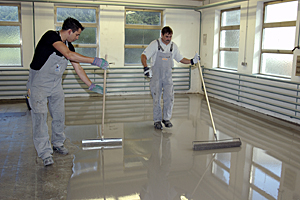Dec 14 2007
High ceilings graced with decorative stucco elements, antique wing doors, generously proportioned rooms: increasingly, people are opting for the distinctive ambience of a tastefully renovated older building. But when refurbishment involves laying new ceramic floors, older dwellings also present very special problems. Problems for which PCI Augsburg GmbH, a BASF subsidiary company, has now developed the all-in-one solution – PCI Nanosilent®. Most of the old suspended ceilings, for example, are made from a combination of materials that expand to differing degrees in response to variations in temperature and humidity. Cracks can appear in freshly laid tiled floors and have to be prevented by mechanically isolating the floor covering from the substrate. The sound insulating properties of old walls often also leave much to be desired: without additional footfall sound insulation for the floors, a latish evening with friends could soon lead to trouble with the neighbors.
The traditional technique is demanding and time-consuming: firstly, irregularities and cracks in the substrate have to be eliminated by applying a levelling compound. Only when this has cured can the sheets for isolation and footfall sound reduction be laid. The craftsman has to cut them precisely to shape and stick them onto the substrate. When the adhesive has set, he has to seal the joints between the sheets with adhesive tape before the tile adhesive can be poured on top.

Levelling, isolation, sound reduction – with PCI Nanosilent®, PCI Augsburg has developed a new, self-levelling isolation compound that combines these three steps into a single operation. "Previously, preparing the substrate took several days, mainly because of the long times spent waiting for the levelling course and adhesive to set," explains Theo Baumstark, tiler from Wiesbaden, Germany. "With PCI Nanosilent®, all you need do is pour, spread, deaerate – and you're done! And you can start laying the tiles the very next day." The isolation mortar derives its special properties from its additives, special polymers and rubber granules. These rubber particles provide the high flexibility of PCI Nanosilent® after it has cured and are responsible for the product's outstanding isolating properties. A study performed by Munich Technical University puts the reduction in tension at 86 percent (by comparison: 100 percent would represent a non-stuck tile that can move completely freely).
"Manufacturing these special rubber granules and especially embedding them optimally in the cement matrix were the toughest challenges we faced when developing PCI Nanosilent®," says Elke Thiergärtner, Product Manager for tiling materials at the BASF subsidiary in Augsburg. The effort was certainly worth it, because the flexibility of the isolation mortar produced by the tiny particles of rubber provide excellent footfall sound reduction. "Tests conducted by the Leipzig Material Research and Testing Institute showed that a footfall sound reduction of 11 decibels was achieved with a PCI Nanosilent® layer thickness of 10 millimeters. This is approximately equivalent to halving the perceived footfall sound and is within the same range as for conventional sound insulating boards," comments Manfred Schnell, Professor of Construction Engineering at Augsburg Technical College.
Irregularities in the old substrate are no problem anyway for PCI Nanosilent®: since the powder is mixed with water and applied in liquid form, layer thicknesses of 5 to 15 millimeters, and in some cases as much as 20, can easily be obtained with the self-levelling isolation compound. Products from the "nano" line of PCI Augsburg also make life easier for professionals and do-it-yourselfers during the working steps that follow. The variable flexible mortar PCI Nanolight®, for example, is suitable for laying all types of ceramic flooring. It is also outstandingly productive: with 15 kilograms of PCI Nanolight® the same tiled surface can be laid as with 25 kilograms of conventional flexible mortar. The secret? Fillers of light, expanded glass which in PCI Nanolight® replace the otherwise usual silica sand. When the tiles have finally been laid, the universal flexible joint grout PCI Nanofug® is used, which is suitable for all joint widths and all ceramic floor coverings.
All three products justifiably bear the prefix "nano", as Elke Thiergärtner explains: "The decisive material structures for each function are in the nanoscale range. The special goal in developing these materials was to influence the curing of the mortar so as to produce these optimal nanostructures. They provide improved bonding between the substrate and tile – even with dense and less absorbent ceramics." In most cases, however, the happy occupants of the completely renovated dwelling will likely be unaware of having so much high tech beneath their feet.